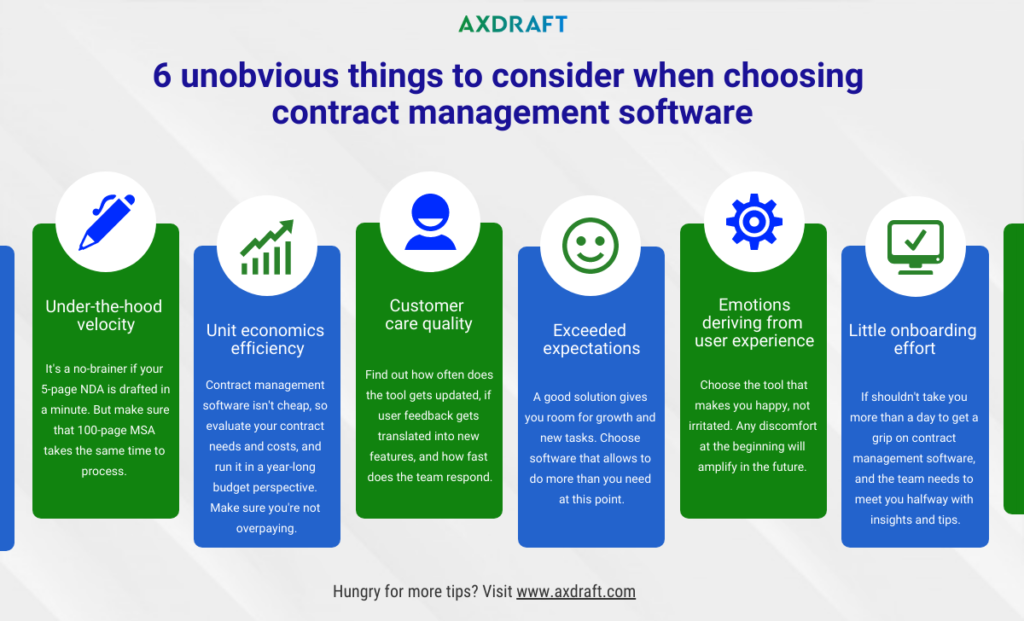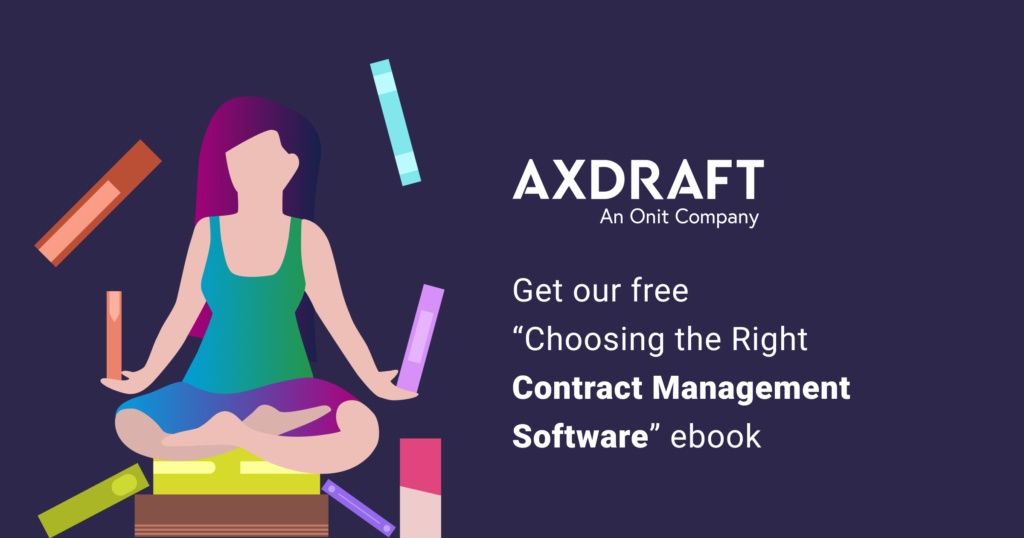Once you decide to adopt contract management software, you may feel you’re already halfway through the process. In reality, however, this is where the difficult part begins. With a multitude of tools available, choosing the right one can seem like a daunting task.
So what should you look for amongst tools with nearly identical features? We’ve completed a comprehensive research of the not-so-obvious document management possibilities to help you make the right decision. Let’s dive straight in.
How to choose contract management software
One of the most common mistakes companies make is choosing a contract lifecycle management software without knowing exactly what they need. First and foremost – assess your requirements and outline the major tasks your contract software must solve. Here is what you should consider:
- Your goals and requirements
- How will you evaluate the efficiency of your contract management system?
- What KPIs will you measure?
- Who will use it?
- What processes will be affected and how deeply?
And don’t forget to be sure of the scope of documents you’ll have to process and the workflows each document will go through.
Now that you have an outline, take a closer look at the things that will actually make up your customer experience.
One of the most common mistakes companies make is choosing a contract lifecycle management software without knowing exactly what they need.
What are the vital features of contract management software?
First, let’s start with the basic features each document management software should have:
- Collaboration and sharing
- Configurable workflows
- Analytics
- Integrations with external services (such as CRMs, e-signatures, e-discovery)
- Cloud storage and smart search
- Friendly interface
- Customization potential
- Realtime notifications and alerts for key contract dates and deadlines
- Risk management ability
These are must-have features for efficient contract management and collaboration with co-workers. Now, let’s inspect the non-superficial things that actually constitute your customer experience.
Quick infographic with key takeaways you can save and reference when choosing the right software

Under the hood velocity
If your 5-page NDA is drafted in a minute, it’s a no-brainer. Just make sure your 100-page MSA takes the same time to process.
When giving demos, many companies can show you how to draft a simple NDA, but they are typically quite generic and require little time to generate. It is better to request a more complex and voluminous contract demo, so you can get a clearer picture of the tool’s potential. What you don’t want is software that takes 30 minutes to process a single large document.
Unit economics efficiency of the document management software
Compare and analyze contract lifecycle management software pricing. Usually, it isn’t cheap, so evaluate your contract needs and costs, and run through a year-long budget perspective. Be sure you don’t overpay.
Identifying your needs helps avoid overspending. CLM is used to know the value of your legal operations. If the vendor does not offer a price package that correlates with your contract needs and volume, or lacks saving you time – look for a different solution.
The ROI on contract management software should be obvious, so be sure to include it in your calculations.

Customer care quality
Confirm how often the tool is updated and how fast the team responds. This is not only about speed when answering you (which should go without saying), but the actual value you receive when communicating with the support team.
At the end of the day, you want more than a simple tool; you want a partner in legal operations. Your choice of contract management should imply there are genuine people behind the software that can help you solve practical tasks.
Exceeded expectations
Yes, you heard right. A good solution gives you room for growth and new tasks. Choose software that allows you to do more than you need currently.
Most likely, your workflows will change over time, along with your contract volumes and business processes. It is wise to choose a tool that allows room for scaling and grows alongside you.
Keep in mind, however, too many opportunities can sometimes mean too little opportunity because of poor quality. If the tool has tons of unclear or unpolished features, you may receive little value in return.
Emotions deriving from user experience
Choose the tool that makes you happy, not irritated. Any discomfort at the beginning will only amplify in the future.
If workarounds make little sense to you now or require too much effort from your side, it may worsen moving forward. Great software should be enjoyable, not frustrating. Investing your time in processes that go against your comfort will not pay off in the long run.
Little onboarding effort
It should take you one day max to get a grip on contract management software, and the onboarding team needs to meet you halfway with insights and tips. This doesn’t mean throwing in a few emails with links to the knowledge base, but taking time to explain how things work in a way that helps you understand.
At AXDRAFT, for instance, we liberate our clients from the need to build templates by preparing them for our customers in the first rollout. This allows us to offer an out-of-the-box solution that is ready for work.
Bottom line
Remember, contract management software is not just a tool, it’s a dedicated partner you can rely on. When choosing your software wisely, depending on your organizational requirements and contract management needs, it has the enormous potential to transform how your company or team handles contracts. The right tool will help you with the nitty-gritty of contract management and chip away all the connected issues. We hope our tips will help you seamlessly work through the adoption process and make the right decision.